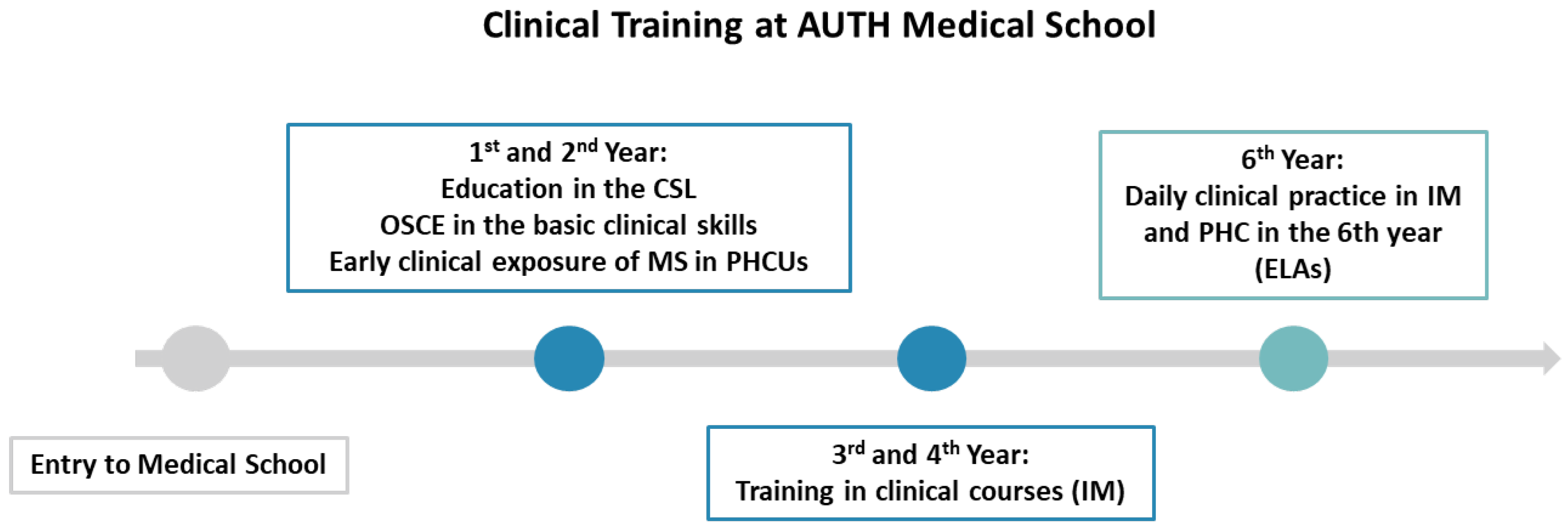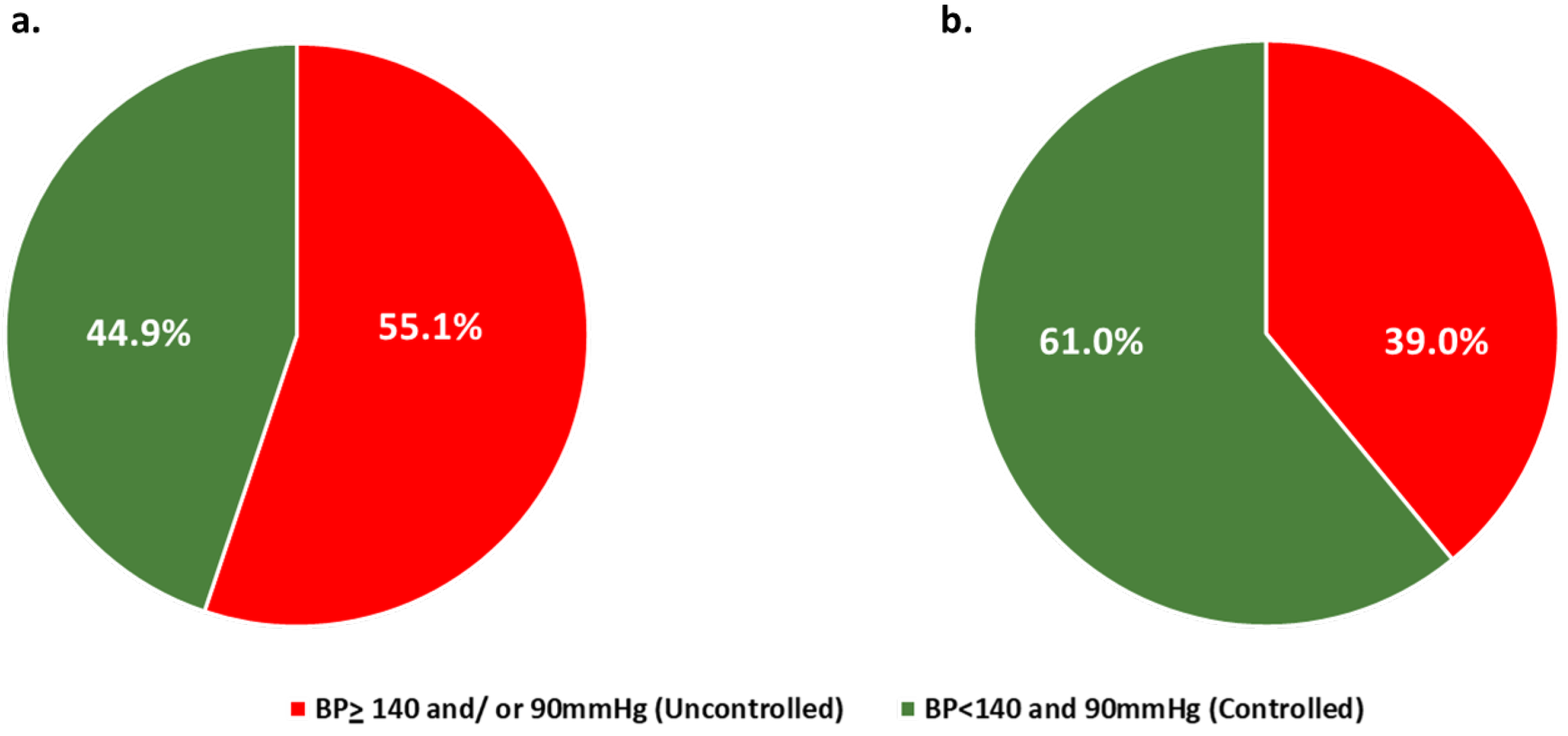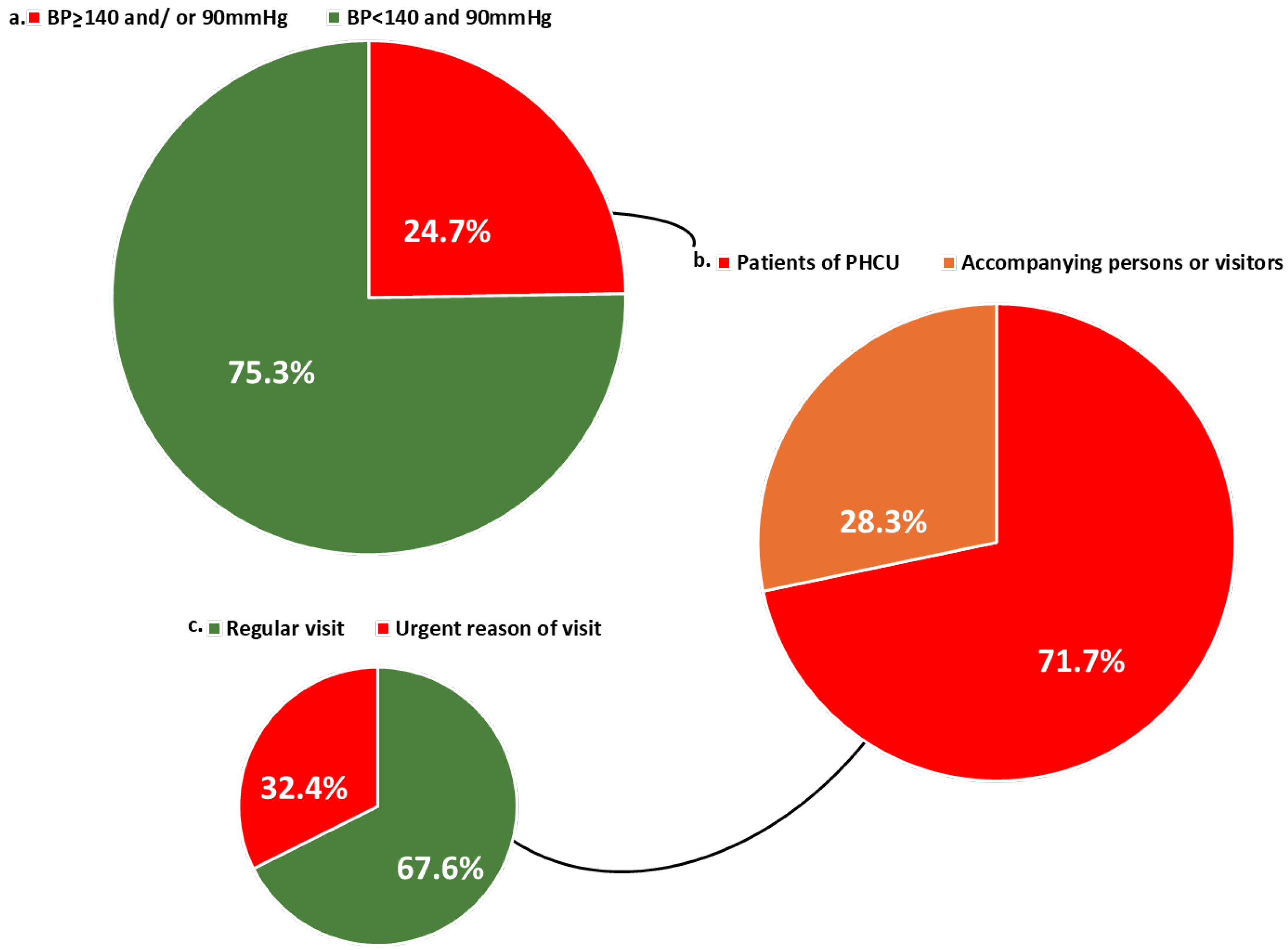Contribution of Final-Year Medical Students to Hypertension Diagnosis in Primary Care Units
Abstract
1. Introduction
2. Materials and Methods
2.1. Study Settings, Training, and Participation of Medical Students
2.2. Study Design, BP Measurements, and Data Collection
- Prevalence of Hypertension: SBP > 140 and/or/DBP > 90 mmHg and/or self-reported use of anti-hypertensive medication.
- Control: SBP < 140 and DBP < 90 mmHg among hypertensive individuals.
- Control under treatment: SBP < 140 and DBP < 90 mmHg in patients receiving anti-hypertensive medication.
- Normal BP (normotensives): SBP < 140 and DBP < 90 mmHg in individuals with no use of anti-hypertensive medication (self-reported).
2.3. Statistical Analysis
3. Results
3.1. Study Participants
3.2. Prevalence and Control of Hypertension Among Participants
3.3. Contribution of Medical Students: Identification of Newly Diagnosed and Uncontrolled Hypertensive Individuals
4. Discussion
4.1. Comparison with Similar International and National Studies
4.2. Educational and Clinical Implications of Involving Students in Screening
4.3. Limitations and Future Research Directions
5. Conclusions
Author Contributions
Funding
Institutional Review Board Statement
Informed Consent Statement
Data Availability Statement
Acknowledgments
Conflicts of Interest
Abbreviations
| AUTH | Aristotle University of Thessaloniki |
| BP | Blood pressure |
| CI | Confidence interval |
| CVD | Cardiovascular disease |
| DBP | Diastolic blood pressure |
| ELAs | Experiential learning activities |
| ESH | European Society of Hypertension |
| IPC | Interprofessional care |
| IQR | Interquartile range |
| GP | General practice |
| MMM | May Measurement Month |
| OSCE | Observed structured clinical exams |
| PHC | Primary healthcare |
| PHCUs | Primary health care units |
| SBP | Systolic blood pressure |
| SMD | Standard mean difference |
| SD | Standard deviation |
| Vs. | Versus |
References
- Brauer, M.; Roth, G.A.; Aravkin, A.Y.; Zheng, P.; Abate, K.H.; Abate, Y.H.; Abbafati, C.; Abbasgholizadeh, R.; Abbasi, M.A.; Abbasian, M.; et al. Global Burden and Strength of Evidence for 88 Risk Factors in 204 Countries and 811 Subnational Locations, 1990–2021: A Systematic Analysis for the Global Burden of Disease Study 2021. Lancet 2024, 403, 2162–2203. [Google Scholar] [CrossRef]
- World Health Organization. Cardiovascular Diseases (CVDs). Fact Sheet. World Health Organization. 2025. Available online: https://www.Who.Int/News-Room/Fact-Sheets/Detail/Cardiovascular-Diseases-(CVDs) (accessed on 4 November 2025).
- Murray, C.J.L.; Aravkin, A.Y.; Zheng, P.; Abbafati, C.; Abbas, K.M.; Abbasi-Kangevari, M.; Abd-Allah, F.; Abdelalim, A.; Abdollahi, M.; Abdollahpour, I.; et al. Global Burden of 87 Risk Factors in 204 Countries and Territories, 1990–2019: A Systematic Analysis for the Global Burden of Disease Study 2019. Lancet 2020, 396, 1223–1249. [Google Scholar] [CrossRef]
- Zhou, B.; Perel, P.; Mensah, G.A.; Ezzati, M. Global Epidemiology, Health Burden and Effective Interventions for Elevated Blood Pressure and Hypertension. Nat. Rev. Cardiol. 2021, 18, 785–802. [Google Scholar] [CrossRef]
- Beaney, T.; Kerr, G.K.; Kiru, G.; McArdle, H.; Schlaich, M.; Schutte, A.E.; Stergiou, G.S.; Wang, J.-G.; Marin, M.J.; Henandez-Hernandez, R.; et al. May Measurement Month 2022: Results from the Global Blood Pressure Screening Campaign. BMJ Glob Health 2024, 9, e016557. [Google Scholar] [CrossRef]
- Stergiou, G.S.; Menti, A.; Kalpourtzi, N.; Gavana, M.; Vantarakis, A.; Chlouverakis, G.; Hajichristodoulou, C.; Trypsianis, G.; Voulgari, P.V.; Alamanos, Y.; et al. Prevalence, Awareness, Treatment and Control of Hypertension in Greece: EMENO National Epidemiological Study. J. Hypertens. 2021, 39, 1034–1039. [Google Scholar] [CrossRef] [PubMed]
- Pinho, R.d.; Albini, F.; Nemcsik, J.; Doumas, M.; Kreutz, R. European Society of Hypertension-General Practitioners’ Program Hypertension Management: Focus on General Practice. Blood Press. 2023, 32, 2265132. [Google Scholar] [CrossRef]
- Jeemon, P.; Séverin, T.; Amodeo, C.; Balabanova, D.; Campbell, N.R.C.; Gaita, D.; Kario, K.; Khan, T.; Melifonwu, R.; Moran, A.; et al. World Heart Federation Roadmap for Hypertension–A 2021 Update. Glob Heart 2021, 16, 63. [Google Scholar] [CrossRef] [PubMed]
- Krist, A.H.; Davidson, K.W.; Mangione, C.M.; Cabana, M.; Caughey, A.B.; Davis, E.M.; Donahue, K.E.; Doubeni, C.A.; Kubik, M.; Li, L.; et al. Screening for Hypertension in Adults. JAMA 2021, 325, 1650. [Google Scholar] [CrossRef] [PubMed]
- Ulusoy, Ş.; Özkan, G.; Güvercin, B.; Sökmen, Y.; Erdem, Y. Do Physicians Measure Patients’ Blood Pressure, and Are Those Measurements Reliable? J. Hum. Hypertens. 2018, 32, 203–211. [Google Scholar] [CrossRef]
- Hsu, C.; Hansell, L.; Ehrlich, K.; Munson, S.; Anderson, M.; Margolis, K.L.; McClure, J.B.; Hall, Y.N.; Thompson, M.; Joseph, D.; et al. Primary Care Physician Beliefs and Practices Regarding Blood Pressure Measurement: Results from BP-CHECK Qualitative Interviews. BMC Prim. Care 2023, 24, 30. [Google Scholar] [CrossRef]
- Nemcsik, J.; Takács, J.; Pásztor, D.; Farsang, C.; Simon, A.; Páll, D.; Torzsa, P.; Dolgos, S.; Koller, A.; Habony, N.; et al. Frequency of Office Blood Pressure Measurements and the Seasonal Variability of Blood Pressure: Results of the Hungarian Hypertension Registry. Blood Press. 2024, 33, 2337170. [Google Scholar] [CrossRef]
- Evangelidis, N.; Smyrnakis, E.; Staikos, I.; Gkolias, V.; Ouzouni, S.; Tsotoulidis, S.; Gavana, M.; Haidich, A.-B.; Doumas, M.; Triantafyllou, A. Need to take action for hypertension: A survey on the practices of primary care physicians towards blood pressure measurement in Greece. J. Hypertens. 2025, 43, e131–e132. [Google Scholar] [CrossRef]
- Imam, H.; Sundström, J.; Lind, L. Evaluation of Time Delay between Discovery of a High Blood Pressure in a Health Screening Survey and Hypertension Diagnosis. Blood Press. 2020, 29, 370–374. [Google Scholar] [CrossRef]
- Lee, J.K.; McCutcheon, L.R.M.; Fazel, M.T.; Cooley, J.H.; Slack, M.K. Assessment of Interprofessional Collaborative Practices and Outcomes in Adults with Diabetes and Hypertension in Primary Care. JAMA Netw. Open 2021, 4, e2036725. [Google Scholar] [CrossRef]
- Cheung, A.K.; Whelton, P.K.; Muntner, P.; Schutte, A.E.; Moran, A.E.; Williams, B.; Sarafidis, P.; Chang, T.I.; Daskalopoulou, S.S.; Flack, J.M.; et al. International Consensus on Standardized Clinic Blood Pressure Measurement—A Call to Action. Am. J. Med. 2023, 136, 438–445.e1. [Google Scholar] [CrossRef]
- Team-Based Care to Improve Blood Pressure Control. CDC. Available online: https://www.cdc.gov/high-blood-pressure/php/data-research/team-based-care/index.html (accessed on 4 November 2025).
- Khalili, H.; Thistlethwaite, J.; El-Awaisi, A.; Pfeifle, A.; Gilbert, J.; Lising, D.; MacMillan, K.; Maxwell, B.; Grymonpre, R.; Rodrigues, F.F.J.; et al. Guidance on Global Interprofessional Education and Collaborative Practice Research: Discussion Paper; InterprofessionalResearch.Global & Interprofessional.Global, 2019. Available online: https://interprofessionalresearch.global (accessed on 17 November 2025).
- Bouton, C.; Journeaux, M.; Jourdain, M.; Angibaud, M.; Huon, J.-F.; Rat, C. Interprofessional Collaboration in Primary Care: What Effect on Patient Health? A Systematic Literature Review. BMC Prim. Care 2023, 24, 253. [Google Scholar] [CrossRef]
- Samuelson, M.; Tedeschi, P.; Aarendonk, D.; de la Cuesta, C.; Groenewegen, P. Improving Interprofessional Collaboration in Primary Care: Position Paper of the European Forum for Primary Care. Qual. Prim. Care 2012, 20, 303–312. [Google Scholar]
- Davis, K.; Doole, E.; Cheek, C.; Shires, L. How Medical Students Learn in Primary Care. Clin. Teach. 2019, 16, 474–478. [Google Scholar] [CrossRef]
- Punzalan, J.K.; Guingona, M.; Punzalan, M.G.; Cristobal, F.; Frahsa, A.; Liwanag, H.J. The Integration of Primary Care and Public Health in Medical Students’ Training Based on Social Accountability and Community-Engaged Medical Education. Int. J. Public. Health 2023, 68, 1605359. [Google Scholar] [CrossRef] [PubMed]
- Liu, R.; Su, K.W.; Chen, S.I.; Oray-Schrom, P. Medical Students as Primary Care Providers: A Novel Curriculum Enhancing Understanding of Chronic Disease Management. Int. J. Med. Educ. 2016, 7, 263–264. [Google Scholar] [CrossRef] [PubMed]
- Bhat, S.; Sudeep, K. Medical Students as Diabetes Educators. Muller. J. Med. Sci. Res. 2017, 8, 6. [Google Scholar] [CrossRef]
- Rakotz, M.K.; Townsend, R.R.; Yang, J.; Alpert, B.S.; Heneghan, K.A.; Wynia, M.; Wozniak, G.D. Medical Students and Measuring Blood Pressure: Results from the American Medical Association Blood Pressure Check Challenge. J. Clin. Hypertens. 2017, 19, 614–619. [Google Scholar] [CrossRef]
- González-López, J.J.; Ramírez, J.G.-A.; García, R.T.; Esteban, S.A.; del Barrio, J.A.; Rodríguez-Artalejo, F. Knowledge of Correct Blood Pressure Measurement Procedures Among Medical and Nursing Students. Rev. Española De Cardiol. 2009, 62, 568–571. [Google Scholar] [CrossRef] [PubMed]
- Savvidou, E.; Evangelidis, N.; Gavana, M.; Triantafyllou, A.; Gkolias, V.; Smyrnakis, E. Primary Care Clinical Training: Engaging Medical Students in Direct Patient Care. Educ. Prim. Care, 2025; 1–2, ahead-of-print. [Google Scholar] [CrossRef]
- Savvidou, E.; Evangelidis, N.; Evangelidis, P.; Avramidou, E.; Nteli, M.; Nteli, D.; Nastas, T.; Sitmalidou, M.; Vitoris, I.; Smyrnakis, E. Final-Year Medical Students’ Self-Assessment of Their Competence to Perform 123 Clinical Skills: A Cross-Sectional Study in Greece. Hippokratia 2024, 28, 109–114. [Google Scholar]
- Mancia, G.; Kreutz, R.; Brunström, M.; Burnier, M.; Grassi, G.; Januszewicz, A.; Muiesan, M.L.; Tsioufis, K.; Agabiti-Rosei, E.; Algharably, E.A.E.; et al. 2023 ESH Guidelines for the Management of Arterial Hypertension The Task Force for the Management of Arterial Hypertension of the European Society of Hypertension. J. Hypertens. 2023, 41, 1874–2071. [Google Scholar] [CrossRef]
- Stergiou, G.S.; O’Brien, E.; Myers, M.; Palatini, P.; Parati, G. STRIDE BP: An International Initiative for Accurate Blood Pressure Measurement. J. Hypertens. 2020, 38, 395–399. [Google Scholar] [CrossRef] [PubMed]
- Convenience Sampling. In Encyclopedia of Survey Research Methods; Sage Publications, Inc.: Thousand Oaks, CA, USA, 2008.
- Chow, C.K.; Teo, K.K.; Rangarajan, S.; Islam, S.; Gupta, R.; Avezum, A.; Bahonar, A.; Chifamba, J.; Dagenais, G.; Diaz, R.; et al. Prevalence, Awareness, Treatment, and Control of Hypertension in Rural and Urban Communities in High-, Middle-, and Low-Income Countries. JAMA 2013, 310, 959–968. [Google Scholar] [CrossRef]
- Prieto-Díaz, M.A.; Pallares-Carratala, V.; Manuel Micó-Pérez, R.; Escobar-Cervantes, C.; Martín-Sanchez, V.; Coca, A.; Barquilla-García, A.; Velilla-Zancada, S.M.; Polo-García, J.; Segura-Fragoso, A.; et al. Clinical Characteristics, Treatment, and Blood Pressure Control in Patients with Hypertension Seen by Primary Care Physicians in Spain: The IBERICAN Study. Front. Cardiovasc. Med. 2023, 10, 1295174. [Google Scholar] [CrossRef]
- Del Pinto, R.; Grassi, G.; Muiesan, M.L.; Borghi, C.; Carugo, S.; Cicero, A.F.G.; Di Meo, L.; Iaccarino, G.; Minuz, P.; Mulatero, P.; et al. World Hypertension Day 2021 in Italy: Results of a Nationwide Survey. High Blood Press. Cardiovasc. Prev. 2022, 29, 353–359. [Google Scholar] [CrossRef]
- Menti, A.; Kollias, A.; Papadakis, J.A.; Kalaitzidis, R.G.; Milionis, H.; Krokidis, X.; Nikitas, G.; Maragkoudakis, S.; Makaris, E.; Papachristou, E.; et al. Prevalence, Awareness, and Control of Hypertension in Greece before and after the COVID-19 Pandemic: May Measurement Month Survey 2019–2022. Hell. J. Cardiol. 2024; in press. [Google Scholar] [CrossRef]
- Triantafyllou, A.; Douma, S.; Petidis, K.; Doumas, M.; Panagopoulou, E.; Pyrpasopoulou, A.; Tsotoulidis, S.; Zamboulis, C. Prevalence, Awareness, Treatment and Control of Hypertension in an Elderly Population in Greece. Rural. Remote Health 2010, 10, 1225. [Google Scholar] [CrossRef]
- Skliros, E.A.; Papaioannou, I.; Sotiropoulos, A.; Giannakaki, G.; Milingou, M.; Lionis, C. A High Level of Awareness but a Poor Control of Hypertension among Elderly Greeks. The Nemea Primary Care Study. J. Hum. Hypertens. 2002, 16, 285–287. [Google Scholar] [CrossRef]
- Efstratopoulos, A.; Voyaki, S.; Baltas, A.; Vratsistas, F.; Kirlas, D.; Kontoyannis, J.; Sakellariou, J.; Triantaphyllou, G.; Alokrios, G.; Lianas, D. Prevalence, Awareness, Treatment and Control of Hypertension in Hellas, GreeceThe Hypertension Study in General Practice in Hellas (HYPERTENSHELL) National Study. Am. J. Hypertens. 2006, 19, 53–60. [Google Scholar] [CrossRef]
- Scheffer, C.; Edelhäuser, F.; Tauschel, D.; Riechmann, M.; Tekian, A. Can Final Year Medical Students Significantly Contribute to Patient Care? A Pilot Study about the Perception of Patients and Clinical Staff. Med. Teach. 2010, 32, 552–557. [Google Scholar] [CrossRef] [PubMed]
- Yardley, S.; Teunissen, P.W.; Dornan, T. Experiential Learning: Transforming Theory into Practice. Med. Teach. 2012, 34, 161–164. [Google Scholar] [CrossRef]
- Nadarajan, G.D.; Rasappan, K.; Ng, J.S.Y.; Junchen, M.L.; Yoon, S. Medical Students’ Experience and Learning Outcomes of Overseas Community Involvement Project: A Qualitative Study. BMC Med. Educ. 2024, 24, 854. [Google Scholar] [CrossRef]
- Ampofo, G.D.; Osarfo, J.; Tagbor, H.K. Medical Students’ Perceptions of a Community-Engaged Learning Approach to Community Health in Ghana: The Students’ Community Engagement Programme (SCEP). BMC Med. Educ. 2024, 24, 1400. [Google Scholar] [CrossRef] [PubMed]
- Bray, P.; Cummings, D.M.; Morrissey, S.; Thompson, D.; Holbert, D.; Wilson, K.; Lukosius, E.; Tanenberg, R. Improved Outcomes in Diabetes Care for Rural African Americans. Ann. Fam. Med. 2013, 11, 145–150. [Google Scholar] [CrossRef] [PubMed]
- Cueto-Manzano, A.M.; Martínez-Ramírez, H.R.; Cortés-Sanabria, L. Comparison of Primary Health-Care Models in the Management of Chronic Kidney Disease. Kidney Int Suppl. 2013, 3, 210–214. [Google Scholar] [CrossRef]
- Jiao, F.F.; Fung, C.S.C.; Wong, C.K.H.; Wan, Y.F.; Dai, D.; Kwok, R.; Lam, C.L.K. Effects of the Multidisciplinary Risk Assessment and Management Program for Patients with Diabetes Mellitus (RAMP-DM) on Biomedical Outcomes, Observed Cardiovascular Events and Cardiovascular Risks in Primary Care: A Longitudinal Comparative Study. Cardiovasc. Diabetol. 2014, 13, 127. [Google Scholar] [CrossRef]
- Saito, M.; Khan, F.; Stoklosa, T.; Iannaccone, A.; Negishi, K.; Marwick, T.H. Prognostic Implications of LV Strain Risk Score in Asymptomatic Patients with Hypertensive Heart Disease. JACC Cardiovasc. Imaging 2016, 9, 911–921. [Google Scholar] [CrossRef]
- Sonaglioni, A.; Napoli, F.; Dell’Anna, R.; Nicolosi, G.L.; Bianchi, S.; Lombardo, M.; Harari, S.; Lonati, C. Comprehensive Assessment of Biventricular and Biatrial Myocardial Strain Parameters at Six Years Postpartum in a Cohort of Women with Previous Hypertensive Disorders of Pregnancy. J. Clin. Med. 2025, 14, 4767. [Google Scholar] [CrossRef] [PubMed]
- Triantafyllou, A.; Evangelidis, N.; Kavvadas, D.; Evangelidis, P.; Gkolias, V.; Ouzouni, S.; Stachteas, P.; Gavana, M.; Haidich, A.B.; Doumas, M.; et al. Developing an Experiential Learning Activity for Blood Pressure Measurements: Results from a Qualitative Analysis of Final-Year Medical Students’ Experiences. Hippokratia 2024, 28, 72–78. [Google Scholar]
- Drawz, P.E.; Ix, J.H. BP Measurement in Clinical Practice: Time to SPRINT to Guideline-Recommended Protocols. J. Am. Soc. Nephrol. 2018, 29, 383–388. [Google Scholar] [CrossRef]
- SPRINT Research Group. A Randomized Trial of Intensive versus Standard Blood-Pressure Control. N. Engl. J. Med. 2015, 373, 2103–2116. [Google Scholar] [CrossRef] [PubMed]



| Age (years), median (IQR) | 61.0 (48.0–73.0) |
| Gender, N (%): | |
| Male | 290 (41.2) |
| Female | 414 (58.8) |
| Participant categories, N (%): | |
| Patients | 481 (68.3) |
| Accompanying persons/visitors of PHCU | 223 (31.7) |
| Reason for visiting the PHCU *, N (%): | |
| Regular visit | 543 (77.3) |
| Emergency | 148 (22.7) |
| Current smoker, N (%) | 174 (24.7) |
| Under antihypertensive medication **, N (%): | |
| Yes | 287 (41.2) |
| No | 400 (57.5) |
| Don’t know | 9 (1.3) |
| Dyslipidemia, N (%) | 239 (33.9) |
| Diabetes mellitus, N (%) | 120 (17.0) |
| Atrial fibrillation, N (%) | 44 (6.3) |
| Normotensive Individuals N = 305 | Hypertensive Individuals N = 399 | p | |
|---|---|---|---|
| Age (years), median (IQR) | 50 (34–60.5) | 69 (58–77) | <0.001 |
| Gender, N (%): | |||
| Male | 90 (29.5) | 200 (50.1) | <0.001 |
| Female | 215 (70.5) | 199 (49.9) | |
| Category of participants, N (%): | |||
| Patients | 170 (55.7) | 311 (77.9) | <0.001 |
| Accompanying persons/visitors of PHCU | 135 (44.3) | 88 (22.1) | |
| Reason for visiting the PHCU, N (%): | |||
| Regular visit | 228 (77.6) | 315 (79.3) | 0.570 |
| Emergency | 66 (22.4) | 82 (20.7) | |
| Current smoker, N (%) | 81 (26.6) | 93 (23.3) | 0.322 |
| Dyslipidemia, N (%) | 59 (19.3) | 180 (45.1) | <0.001 |
| Diabetes mellitus, N (%) | 24 (7.9) | 96 (24.1) | <0.001 |
| Atrial fibrillation, N (%) | 4 (1.3) | 40 (10) | <0.001 |
| Controlled Individuals Under Treatment N = 175 | Uncontrolled Individuals Under Treatment N = 112 | p | |
|---|---|---|---|
| Age (years), median (IQR) | 71 (62–79) | 74 (66–79) | 0.095 |
| Gender, N (%): | |||
| Male | 79 (45.1) | 63 (56.2) | 0.066 |
| Female | 96 (54.9) | 49 (43.8) | |
| Category of participants, N (%): | |||
| Patients | 136 (77.7) | 93 (83.0) | 0.273 |
| Accompanying persons/visitors of PHCU | 39 (22.3) | 19 (17.0) | |
| Reason for visiting the PHCU, N (%): | |||
| Regular visit | 147 (85.0) | 88 (78.6) | 0.165 |
| Emergency | 26 (15.0) | 24 (21.4) | |
| Current smoker, N (%) | 37 (21.1) | 19 (17.0) | 0.384 |
| Dyslipidemia, N (%) | 85 (48.6) | 66 (58.9) | 0.086 |
| Diabetes mellitus, N (%) | 48 (27.4) | 35 (31.3) | 0.486 |
| Atrial fibrillation, N (%) | 21 (12.0) | 15 (13.4) | 0.728 |
Disclaimer/Publisher’s Note: The statements, opinions and data contained in all publications are solely those of the individual author(s) and contributor(s) and not of MDPI and/or the editor(s). MDPI and/or the editor(s) disclaim responsibility for any injury to people or property resulting from any ideas, methods, instructions or products referred to in the content. |
© 2025 by the authors. Licensee MDPI, Basel, Switzerland. This article is an open access article distributed under the terms and conditions of the Creative Commons Attribution (CC BY) license (https://creativecommons.org/licenses/by/4.0/).
Share and Cite
Evangelidis, N.; Triantafyllou, A.; Gavana, M.; Gkolias, V.; Ouzouni, S.; Evangelidis, P.; Theodoropoulos, I.; Symintiridou, D.; Naka, E.; Staikos, I.; et al. Contribution of Final-Year Medical Students to Hypertension Diagnosis in Primary Care Units. Clin. Pract. 2025, 15, 216. https://doi.org/10.3390/clinpract15110216
Evangelidis N, Triantafyllou A, Gavana M, Gkolias V, Ouzouni S, Evangelidis P, Theodoropoulos I, Symintiridou D, Naka E, Staikos I, et al. Contribution of Final-Year Medical Students to Hypertension Diagnosis in Primary Care Units. Clinics and Practice. 2025; 15(11):216. https://doi.org/10.3390/clinpract15110216
Chicago/Turabian StyleEvangelidis, Nikolaos, Areti Triantafyllou, Magda Gavana, Vasileios Gkolias, Styliani Ouzouni, Paschalis Evangelidis, Ilias Theodoropoulos, Despoina Symintiridou, Evangelia Naka, Ioannis Staikos, and et al. 2025. "Contribution of Final-Year Medical Students to Hypertension Diagnosis in Primary Care Units" Clinics and Practice 15, no. 11: 216. https://doi.org/10.3390/clinpract15110216
APA StyleEvangelidis, N., Triantafyllou, A., Gavana, M., Gkolias, V., Ouzouni, S., Evangelidis, P., Theodoropoulos, I., Symintiridou, D., Naka, E., Staikos, I., Andreou, M., Tsotoulidis, S., Lamprou, S., Dragasaki, M., Kada, E., Haidich, A.-B., Doumas, M., & Smyrnakis, E. (2025). Contribution of Final-Year Medical Students to Hypertension Diagnosis in Primary Care Units. Clinics and Practice, 15(11), 216. https://doi.org/10.3390/clinpract15110216







